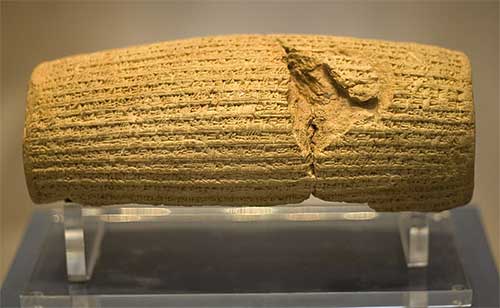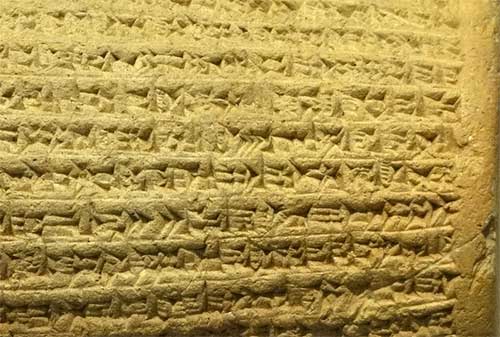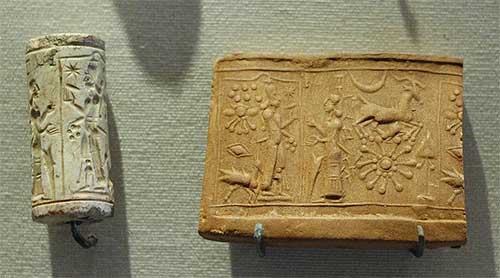It looks like you're using an Ad Blocker.
Please white-list or disable AboveTopSecret.com in your ad-blocking tool.
Thank you.
Some features of ATS will be disabled while you continue to use an ad-blocker.
11
share:

We like to think that the printing press is rather modern and that we have Gutenberg to thank for it. Is that so? The picture above is that of the "Cyrus Cylinder" which could be used to mass produce prints of the laws of Cyrus the Great, either onto clay tablets or papyrus using some kind of ink.
en.wikipedia.org...
The Cyrus Cylinder is a barrel-shaped cylinder of baked clay measuring 22.5 centimetres (8.9 in) by 10 centimetres (3.9 in) at its maximum diameter. It was created in several stages around a cone-shaped core of clay within which there are large grey stone inclusions. It was built up with extra layers of clay to give it a cylindrical shape before a fine surface slip of clay was added to the outer layer, on which the text is inscribed. It was excavated in several fragments, having apparently broken apart in antiquity. Today it exists in two main fragments, known as "A" and "B", which were reunited in 1972.
It's hard to see from the pictures, but the writing on the cylinder looks to me to be negative, indicating that it's use was to mass-replicate prints to be sent out to the Persian provinces. Compare the two pictures below. Aren't they mirrors of eachother?

Compare with

Looks like Gutenberg was beaten by two thousand years. Not bad.
edit on 28-1-2014 by Utnapisjtim because: Added wiki link
shaneslaughta
Now that's cool!
I thought so meself. One of many technologies that was invented long ago and then forgotten until it showed up in our time. Tarmac and concrete are two other examples. The Babylonian mad a kind of asphalt which compared to modern tarmac is of a much higher quality, durability and strength. And the Romans invented concrete only to forget all about it and return to bricks and stone.
Fascinating. Since it's in reverse relief, it would have to be pressed and rolled onto a softer clay in order to leave a raised relief pattern of
lettering. What a lot of work involved in that one message!
reply to post by Utnapisjtim
You want old?
en.wikipedia.org...
There were presses before Gutenberg. Long before. His actual innovation was movable type but even that was old hat as far as the Chinese were concerned.
Looks like Gutenberg was beaten by two thousand years. Not bad.
You want old?
en.wikipedia.org...
edit on 1/28/2014 by Phage because: (no reason given)
Maybe they used it to roll out and make writing on pastry Damn, I got to get food off my mind. Heluva rolling pin.
edit on 28-1-2014 by
rickymouse because: (no reason given)
aboutface
Fascinating. Since it's in reverse relief, it would have to be pressed and rolled onto a softer clay in order to leave a raised relief pattern of lettering. What a lot of work involved in that one message!
Using "modern" movable type presses (still used sometimes to print books), one page of a bible would take about 3 hours to typeset. However, when you have completed typesetting one page, you can use this to print 1000 copies of that page in no-time. The same could be said about the Cyrus Cylinder I suppose.
reply to post by Utnapisjtim
I'm going to disagree with your idea, but admire the concept you've envisaged.
The shape isn't practical for printing as it isn't cylindrical. If someone tested it by rolling the object in ink/paint and then rolling it across some medium like parchment, the tapered area wouldn't create a clear print. Similarly, I tried to imagine the object being rolled across clay to create a bas-relief text and the same problem would arise.
The designer/s of objects like this would recognise that a conventional cylinder is a more accurate tool for printing.
Given the size of the object, it might have been designed with convenience in mind. An item of this size would be easy to carry and there might have been a great number of them that just haven't survived. It's message was clearly political propaganda so I'd imagine many of them were sent to all quarters of the shadowlands of Cyrus' empire.
I'm going to disagree with your idea, but admire the concept you've envisaged.
The shape isn't practical for printing as it isn't cylindrical. If someone tested it by rolling the object in ink/paint and then rolling it across some medium like parchment, the tapered area wouldn't create a clear print. Similarly, I tried to imagine the object being rolled across clay to create a bas-relief text and the same problem would arise.
The designer/s of objects like this would recognise that a conventional cylinder is a more accurate tool for printing.
Given the size of the object, it might have been designed with convenience in mind. An item of this size would be easy to carry and there might have been a great number of them that just haven't survived. It's message was clearly political propaganda so I'd imagine many of them were sent to all quarters of the shadowlands of Cyrus' empire.
Phage
reply to post by Utnapisjtim
Looks like Gutenberg was beaten by two thousand years. Not bad.
There were presses before Gutenberg. Long before. His actual innovation was movable type but even that was old hat as far as the Chinese were concerned.
I am aware of that
You want old?
en.wikipedia.org...
Love the link! Below is a picture off that page:

Wikipedia description: "Mesopotamian limestone cylinder seal and impression—worship of Shamash, (Louvre)"
Kandinsky
reply to post by Utnapisjtim
I'm going to disagree with your idea, but admire the concept you've envisaged.
The shape isn't practical for printing as it isn't cylindrical.
Well, not after 2500 years it's not. It was originally cylindrical, but time has had it's toll. Also, like one member pointed out, it would be used to print blank tablets ("tabula rasa") replicate clay tablets ensuring all copies were "identical".
edit on 28-1-2014 by Utnapisjtim because:
Added last sentence
edit on 28-1-2014 by Utnapisjtim because: typos
reply to post by Utnapisjtim
S+F, the chinese are a mystery before the period of emperor Qin and his purge of the intelligentsia of his unified china was at least as bad if not even worse than the burning of the great library at alexandria, What we do know is the chinese where using printing press with changable character block's hundred's of year's before Gutenbourg from at least 593ad but these ideas may have been even older.
www.minnesota-china.com...
And they were the most technologically advanced nation in the world until an emperor whom was too heavily influenced by Confuscious came to the throne and ordered the nation to look inward, they had only just sent a great fleet called the grand fleet made up of giant chinese junk's that would have dwarfed the NINA, PINTA or SANTA MARIA, the chinese junk has converse bulkheads an idea taked from the cane and this was used to slow or prevent sinking in the event of a hull breech.
library.thinkquest.org...
books.google.co.uk... en&sa=X&ei=zDXoUqv_OafN7AbY4YHADg&ved=0CF0Q6AEwBw#v=onepage&q=The%20chinese%20grand%20fleet&f=false
This scroll imprinter was an early invention that used one of the most successful phonetic alpha bets ever invented the cuniform script, this was in use for well over two thousand years so there is no denying this is a milestone discovery.
Great thread.
S+F, the chinese are a mystery before the period of emperor Qin and his purge of the intelligentsia of his unified china was at least as bad if not even worse than the burning of the great library at alexandria, What we do know is the chinese where using printing press with changable character block's hundred's of year's before Gutenbourg from at least 593ad but these ideas may have been even older.
www.minnesota-china.com...
And they were the most technologically advanced nation in the world until an emperor whom was too heavily influenced by Confuscious came to the throne and ordered the nation to look inward, they had only just sent a great fleet called the grand fleet made up of giant chinese junk's that would have dwarfed the NINA, PINTA or SANTA MARIA, the chinese junk has converse bulkheads an idea taked from the cane and this was used to slow or prevent sinking in the event of a hull breech.
library.thinkquest.org...
books.google.co.uk... en&sa=X&ei=zDXoUqv_OafN7AbY4YHADg&ved=0CF0Q6AEwBw#v=onepage&q=The%20chinese%20grand%20fleet&f=false
This scroll imprinter was an early invention that used one of the most successful phonetic alpha bets ever invented the cuniform script, this was in use for well over two thousand years so there is no denying this is a milestone discovery.
Great thread.
Utnapisjtim
Looks like Gutenberg was beaten by two thousand years. Not bad.edit on 28-1-2014 by Utnapisjtim because: Added wiki link
No, printing of some form was known forever. It is the invention of movable type that makes the difference, and Gutenberg did this and the press. The combination of the two is critical.
Apparently, it was previously invented in Asia before Gutenberg, but because of the expensive, and non-alphabetic script, the importance was small.
reply to post by mbkennel
What originally caught my attention with this cylinder, was that the lettering on it looked like they had been stamped side by side like with lead types.
PS: My mentioning Gutenberg in the end of the OP and 'rotary press' in the headline, doesn't mean I believe the Persians invented off-set and typesetting.
What originally caught my attention with this cylinder, was that the lettering on it looked like they had been stamped side by side like with lead types.
PS: My mentioning Gutenberg in the end of the OP and 'rotary press' in the headline, doesn't mean I believe the Persians invented off-set and typesetting.
reply to post by Utnapisjtim
You have a very good point, it may mean that instead of carving each letter/symbol individualy that they had a form of stamp with the letter engraved on it, given that these ancient library's are perhaps the most extensive survivors of any ancient pre christian litterary treasure it is enlightening to assume they have had a form of scriptorium production line going.
Though worn an analysis of each symbol as it recurres may offer a clue on that.
You have a very good point, it may mean that instead of carving each letter/symbol individualy that they had a form of stamp with the letter engraved on it, given that these ancient library's are perhaps the most extensive survivors of any ancient pre christian litterary treasure it is enlightening to assume they have had a form of scriptorium production line going.
Though worn an analysis of each symbol as it recurres may offer a clue on that.
edit on 29-1-2014 by LABTECH767 because: (no reason given)
some heavy news tablets back then and a hell of an archive store too
emoticons suck , cant chose one they all suck
emoticons suck , cant chose one they all suck
Dr UAE
some heavy news tablets back then and a hell of an archive store too
A typical clay tablet was a base or frame of wood and only a thin layer of soft clay inside you would write upon using a stylus, typically a reed. You may have heared Aristotle whine about 'tabula rasa', that one's such.
emoticons suck , cant chose one they all suck
Like this one -->
LABTECH767
reply to post by Utnapisjtim
You have a very good point, it may mean that instead of carving each letter/symbol individualy that they had a form of stamp with the letter engraved on it,
Exactly my line of thought. That way Cyrus and his fellow kings-of-the-world could exercise authority in a more effective way. They didn't simply receive a letter, but one written in the official Cyrus neue Bold typeface.
given that these ancient library's are perhaps the most extensive survivors of any ancient pre christian litterary treasure it is enlightening to assume they have had a form of scriptorium production line going.
I didn't know that, but your assumption is spot on.
Though worn an analysis of each symbol as it recurres may offer a clue on that.
new topics
-
Nearly 70% Of Americans Want Talks To End War In Ukraine
Political Issues: 7 minutes ago -
Late Night with the Devil - a really good unusual modern horror film.
Movies: 1 hours ago -
Cats Used as Live Bait to Train Ferocious Pitbulls in Illegal NYC Dogfighting
Social Issues and Civil Unrest: 3 hours ago -
The Good News According to Jesus - Episode 1
Religion, Faith, And Theology: 5 hours ago -
HORRIBLE !! Russian Soldier Drinking Own Urine To Survive In Battle
World War Three: 7 hours ago -
Bobiverse
Fantasy & Science Fiction: 10 hours ago -
Florida man's trip overseas ends in shock over $143,000 T-Mobile phone bill
Social Issues and Civil Unrest: 10 hours ago
top topics
-
Florida man's trip overseas ends in shock over $143,000 T-Mobile phone bill
Social Issues and Civil Unrest: 10 hours ago, 8 flags -
SETI chief says US has no evidence for alien technology. 'And we never have'
Aliens and UFOs: 14 hours ago, 7 flags -
Cats Used as Live Bait to Train Ferocious Pitbulls in Illegal NYC Dogfighting
Social Issues and Civil Unrest: 3 hours ago, 7 flags -
This is our Story
General Entertainment: 16 hours ago, 4 flags -
Former Labour minister Frank Field dies aged 81
People: 12 hours ago, 4 flags -
Bobiverse
Fantasy & Science Fiction: 10 hours ago, 3 flags -
Late Night with the Devil - a really good unusual modern horror film.
Movies: 1 hours ago, 2 flags -
HORRIBLE !! Russian Soldier Drinking Own Urine To Survive In Battle
World War Three: 7 hours ago, 2 flags -
The Good News According to Jesus - Episode 1
Religion, Faith, And Theology: 5 hours ago, 0 flags -
Nearly 70% Of Americans Want Talks To End War In Ukraine
Political Issues: 7 minutes ago, 0 flags
active topics
-
Nearly 70% Of Americans Want Talks To End War In Ukraine
Political Issues • 1 • : Disgusted123 -
British TV Presenter Refuses To Use Guest's Preferred Pronouns
Education and Media • 144 • : Consvoli -
Cats Used as Live Bait to Train Ferocious Pitbulls in Illegal NYC Dogfighting
Social Issues and Civil Unrest • 9 • : ImagoDei -
President BIDEN Vows to Make Americans Pay More Federal Taxes in 2025 - Political Suicide.
2024 Elections • 101 • : ImagoDei -
Late Night with the Devil - a really good unusual modern horror film.
Movies • 3 • : Hecate666 -
HORRIBLE !! Russian Soldier Drinking Own Urine To Survive In Battle
World War Three • 23 • : Disgusted123 -
Hi folks I'm Leon Grad
Introductions • 9 • : leongrad -
The Reality of the Laser
Military Projects • 41 • : 5thHead -
Thousands Of Young Ukrainian Men Trying To Flee The Country To Avoid Conscription And The War
Other Current Events • 136 • : NorthOS -
Florida man's trip overseas ends in shock over $143,000 T-Mobile phone bill
Social Issues and Civil Unrest • 16 • : grey580
11
